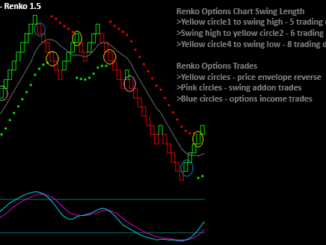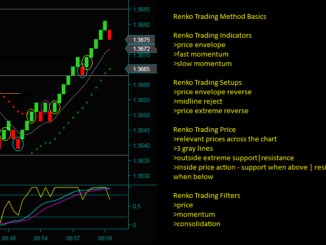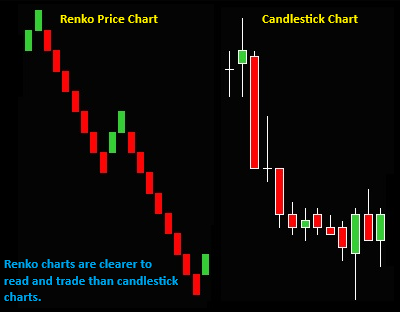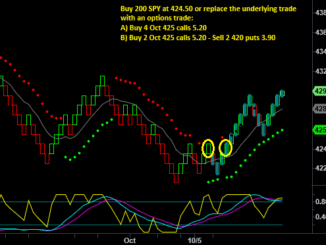Renko chart short options strategies can effectively generate income. Selling out of the money calls and puts or credit spreads for their premium is a way to make income.
Before selling options, one must understand the related risks. Like any trade, shorting options can become losing trades. However, option sellers also have obligations that create expiration and assignment risks.
Ideally, you would hold the options you sell to expiration to maximize the potential income. But there will be times when your short options expire in the money. The options are then assigned, and you will be long or short the underlying. And then the new position has its own set of risks.
This is clearly not the objective for Renko chart short options trading. So, before you sell options for income, you must know the risks and how to manage your trades.
Renko Chart Short Options Risks
What are the risks of selling options?
These include realizing the risk-reward on your trades and especially understanding the assignment risks.
Your assignment risks include in the money options at expiration and early exercise. Also, realize your risks for selling option credit spreads. The short options in credit spreads might not have protection from assignment.
Options Selling Risk-Reward
When saying that the risk-reward of renko short option selling is low, I am referring to the maximum gain compared to the maximum loss.
Let’s look at these risks by comparing selling a QQQ 360 put at 5.00 to buying the QQQ at 370. The first profit graph shows the risk-reward differences.
- The maximum gain from selling the put is the premium you receive. In this case, you sold the put for 5.00, so that’s your maximum gain.
- The maximum gain from your QQQ buy is continuous; you gain $1 for every 1-point move above your purchase price of 370.
- Your maximum loss has the same curvature as the gain; you lose $1 for every 1-point move below 370.
- Your maximum loss for the put is similar to the buy in terms of its profit curvature. The difference is when your trade starts to lose.
- Since you sold the 360 puts for 5.00, you do not start losing until the QQQ goes to 355.
- The QQQ buy starts losing immediately below 370.
- The QQQ has more gain potential, but it has to move above 375 to gain more than shorting the 360 put.
QQQ Short Put Profit Graph

Now look at the second profit graph where you sell the QQQ at 370 and sell a 380 call for 5.00. The relative risk-reward for these are the same as the long QQQ and short put.
- Your maximum short call gain is 5.00, while the short QQQ will continue to gain $1 for each point of movement below 370.
- The short QQQ has to move from 370 to 365 to equal that gain of the short call.
- You do not start losing on the short call until QQQ 385, where the QQQ short starts losing immediately below 370.
- When your short call hits its breakeven at 385, the short QQQ has lost 15 points.
And that is your edge for the Renko chart short options strategies for income.
Options selling for income vs. underlying trading are two different trading strategies. They each have their objectives as well as their associated risks.
While you give up the maximum gain potential from trading the underlying, you also have lower odds for a loss. Additionally, you do not need price movement to receive your maximum gain.
QQQ Short Call Profit Graph
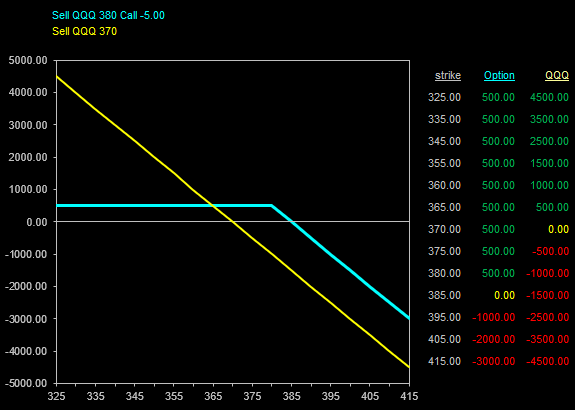
Short Options Assignment Risk
Of all the risks of selling options, knowing about assignment risk is critical. To understand assignment risk, you must know your obligations as an option seller.
Assignment refers to the obligations [risks] of the option seller. People might exercise a short option early for various reasons, but they will only exercise in-the-money options at expiration.
Most options expire out of the money and are worthless, making Renko chart short options strategies a viable income source.
- Short call option: If you sell a call and someone exercises it, you must sell the underlying to the call buyer at the strike price.
- You sell a call with a strike of 20, and someone assigns it when the stock is 25.
- You are effectively short the stock with a loss of 5 points or a loss of $500 for every 1 call you were short. And you did this for maybe a $1 premium or $100 maximum gain per short call.
- Short put option: If you sell a put and someone exercises it, you must buy the underlying from the put buyer at the strike price.
- Consider selling a put with a strike of 20, and then someone exercises it when the stock is 25.
- Your long stock loses 5 points or $500 for every 1 put you were short. And you did this for maybe a $1 premium or $100 maximum gain per short put.
Income Options Annualized Return
Why would you make a trade like this? Why would you take that kind of risk?
Think of the objectives for your Renko chart short options trading; you are trying to generate monthly income.
- Sell an option with a strike of 20 for $1 with 2 months to expiration.
- The premium is 5% of the strike, and if you can do this 6 times per year [every 2 months], you have an annualized return of 30%.
SPY QQQ Short Options And Assignment Risks
Although the SPY and QQQ are related to the SP500 and NASDAQ 100, they are ETFs, not indexes. This means they don’t settle in cash like an SPX option, which settles as an index without an underlying
ETF options settle into shares instead. So, if someone exercises your short options, you hold a long or short position with all the associated risks. You don’t want this outcome for an income-generating Renko chart short options trade.
You also have margin call risk. If someone exercises your short option and you lack the funds for the trade, you might need to add funds or securities to your account.
If you don’t [can’t] do this, your trade can be liquidated to cover the deficit, and you won’t be able to try and manage the position if you want to.
Learn More About Options Assignment And Exercise
Why Option Settlement Style Matters – CBOE
Options Assignment – Options Industry Council
Index Options – Options Industry Council
Do Spreads Protect Short Options From Assignment?
One of our Renko chart short options income strategies is selling credit spreads. For instance, selling a SPY 450 call and buying a 455 call would be a SPY options credit spread because the trade could be made for a credit instead of a debit.
The spread provides a known maximum gain and loss. But it doesn’t protect you from assignment risk unless both legs expire in the money or out of the money.
- The SPY is 450.50 at expiration, so the 450 call expires in the money, and the 455 call expires worthless.
- You are short the SPY at 450.00, which is a .50 loss. But what if the SPY opens at 455.00 on Monday?
- Your SPY short has a 4.50 loss for each assigned short option.
Do not forget the assignment risk for short options spreads when your short option expires in the money, and the long option expires out of the money.
Close your spread before expiration if the short leg is in the money.
Your risk also includes early exercise. You typically won’t face assignment if your short option still has a time premium; selling the option would be more profitable for the buyer.
However, the deeper in the money the short option goes [the higher the delta], the greater the assignment risk. This occurs because deep ITM calls have less liquidity and wider bid-ask spreads. Therefore, the buyer may exercise the option because they cannot sell it to realize the time premium.
Renko Chart Short Options And Managing Risks
If you are going to short options for income only, you must decide how to manage your risks. As discussed above, you need to manage for expirations and assignment risks.
But you also need to manage for trade loss. As you saw on the short option profit graphs, the potential loss can be far greater than the potential gain. So, you must decide a point where you will take a stop loss and exit the trade.
You can also take what I would call protection trades. You would trade these setups using the Renko method to protect the short option.
The profit graph displays the curvature for a short QQQ put you later covered with a long QQQ put. You can see the protection for the short put loss and how the maximum loss becomes zero while maintaining the maximum gain potential.
Note that to do this trade, you would buy a weekly option with around 7 trading days to expiration against a longer-dated option. The 7-day time frame synchs with the longer trading swings I have seen on the Renko charts.
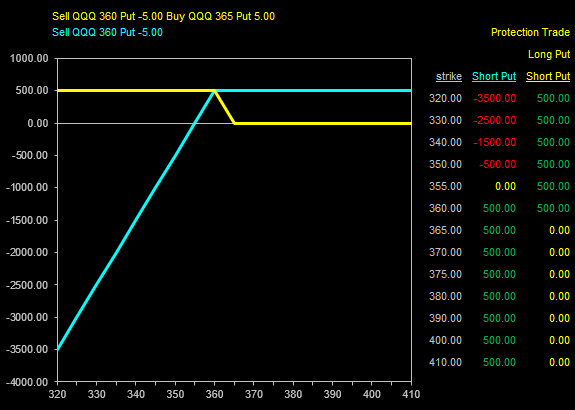
Renko Options Trading Combination Method
You are looking at a Renko chart short options trading layout.
I am using a relatively slower chart [fewer bricks because the size is bigger] because my primary focus for selling options for income is price and momentum extremes.
I marked the chart with circles denoting different trade types.
- Pink circles: Short options income trades.
- Blue circles: Directional trades to protect the short options.
- Yellow circles: Renko method directional trades [includes the blue circles].
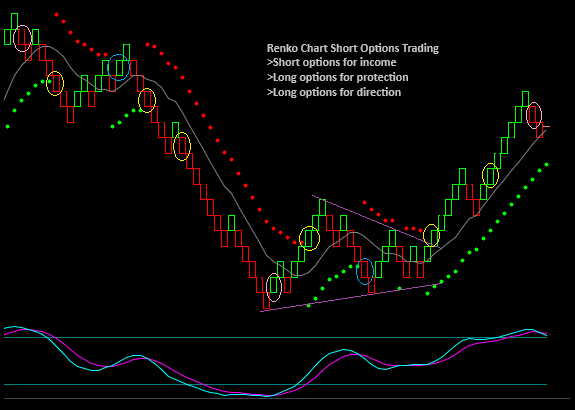
Renko Options Trading Combination Method Benefits
I the combination of methods, selling Renko chart short options for income and trading the Renko method for direction.
The combination of methods will protect the short option income trades while also being able to profit from the underlying price moves.
The results would likely be better [if the Renko options trading method is profitable, then the results are better] than only selecting the Renko trades for protection. Note that when the protection trades lose, they will cut into your options income. You would also miss out on the directional trade winners. If you try this, consider expiration dates and buying weekly options against longer-term short options since their costs would be lower.
When trading the options combination method, your income trades typically begin as managed trades. If you look at the pink circles [income trades] on the charts below, it was against a directional trade when the trades were made. I sold the calls against a profitable buy trade and the puts against a profitable short trade.
These will not become only short options income trades until the Renko trade reverses.
For instance, you sell a call against a profitable long. At this point, your short call is a covered trade. However, if the Renko chart reverses from long to short, I would exit the long position, leaving the short call uncovered for income alone.

